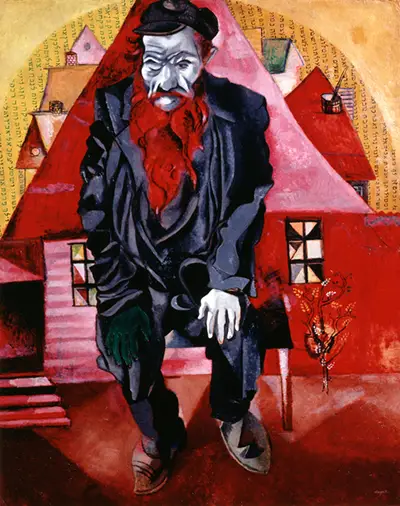This portrait is believed to have been painted in the town of Vitebsk, which Chagall had returned to after a spell living in the French capital, Paris. Whilst back home he would produce a series of paintings that captured his friends, family and also some random locals with whom he was not familiar. There would also be street scenes which captured the good and bad sides of life in this region. He was very bright in palette by now and his contemporary style was fully established in that regard, though with plenty of room left for development in terms of how he produced his forms and which messages lie behind his work.
In Red Jew we find a ageing man looking off into the distance to our left. He is perched on a park bench, or perhaps within a private garden, with a row of rooftops imaginatively depicted in the background. The warm palette boasts a multitude of tones of reds and pinks, with yellows providing contrast in the sky. One can connect this piece to his time in France, with clear similarities to the principles of both Cubism and also Fauvism to be found here. Related paintings that he worked on included Jew in Green and also The Praying Jew, though his religion would ultimately inspire paintings right across the full length of his career.
There appears some confusion over where this painting is now located, with some sources indicating it can be found at the Russian Museum, St Petersburg whilst others place it in the Kunstmuseum in Basel. Both venues host a number of Chagall artworks within their collections and so both are highly plausible answers. Chagall as himself from Eastern Europe and so interest in his career within Russia remains strong, and he was also around at a key time in the region's history, making his work of particular interest. The artist would go onto build a strong reputation across the western world as well, and so makes him a major attraction within the Kunstmuseum as well. Many of his later works were snapped up by private collections, sadly, but he was a highly prolific artist which ensures there are still plenty that the general public can enjoy within public collections such as these.

